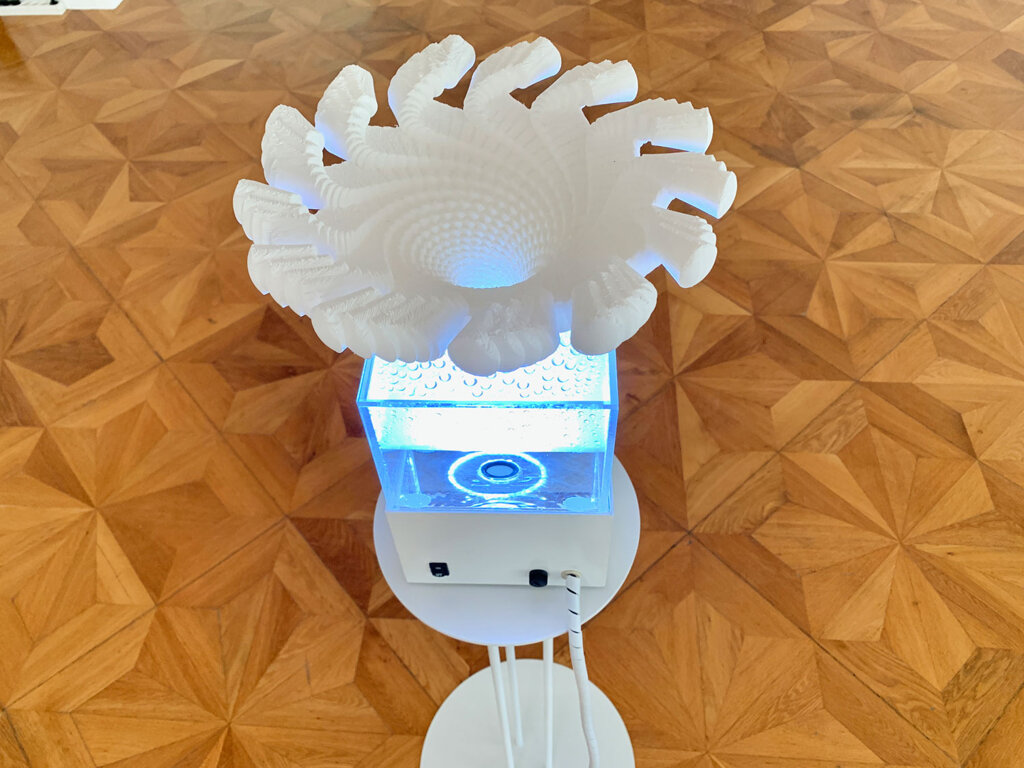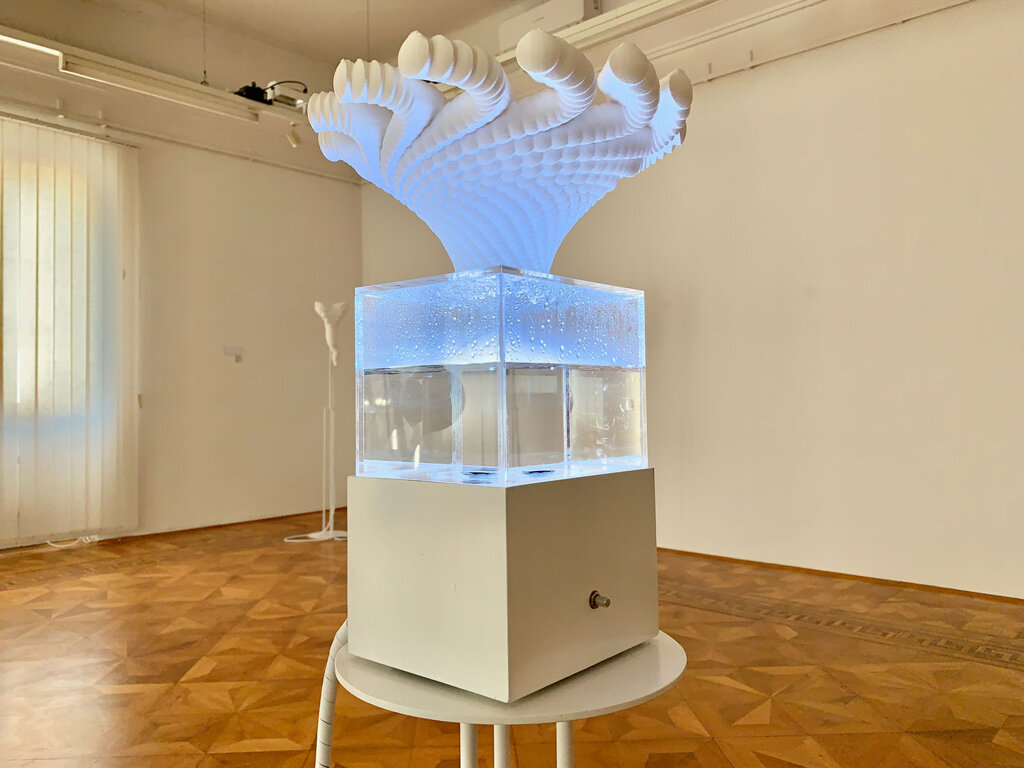Fontana
Sphere2 Fontana
Sculpture
3D prints, steel, water, glassware, custom-made atmospheric pressure plasma generating device, Argon gas, custom-made ultrasonic air humidifier
Advisors
Arijana Filipić, Department of Biotechnology and Systems Biology, National Institute of Biology
Dr. Gregor Primc, Department of Surface Engineering, Jozef Stefan Institute
Dr. Zoran Lj. Petrović, Institute of Physics, University of Belgrade
Hardware: Roman Bevc
Custom-made electronics for Small Fountain: Gregor Krpič
Additional consulting: Jan Kušej
English language editing: Derek Snyder
Production: Ultramono, 2019
The plasma module is produced by the Department of Surface Engineering, Jozef Stefan Institute
Project is supported by Department of Culture of the City of Ljubljana and The Ministry of Culture of the Republic of Slovenia
Inside gardens and parks, fountains are usually placed as central features due to their symbolism, echoing the historical and cosmological role of water as a substance crucial to life on Earth.
How will we overcome the far-reaching consequences of growing environmental pollution? What novel ways can we invent to clean or recycle water already used in the industrial production of goods?
Sometimes referred to as the fourth state of matter, plasma is an ionized gas almost acting as a tiny lightning bolt. In scientific research, plasma is used for various purposes. Among promising features is its ability to destroy harmful microbes in different environments including water. UV radiation, charged particles, and reactive oxygen and/or nitrogen species are plasma’s constituents that have great antimicrobial properties – these reactive species are believed to be the most important in terms of microbe destruction. Plasma might also be the future technology for cleansing the leftover traces of manmade chemical contaminants in water, from toxic dyes to drugs. Research has also indicated that crops or seeds treated with plasma-treated water are more resistant to diseases and can germinate faster, thus producing a higher yield crop. This type of water management might be a potential future technology that will reduce the use of unnecessary chemicals in water cleansing, not only for industrial and agricultural use but also for safe human consumption.
As a potential technology that might be widely used, the treatment of water with plasma is implemented in the installation – plasma-treated water is both the actual agent of change and the symbol of growth and purity.
The Little Fountain (Fontana) is a custom made device that uses ultrasonic piezo technology. The ceramic disk transforms electric energy into vibration. The sound produced by this transducer is beyond the hearing range of humans. Submerged in water, it vibrates, and by doing so it deforms the structure of the water and disperses it into the air as approximately one-micron-sized droplets. These droplets form the fog which hangs throughout the space.
Fontana
Sphere2 Fontana
Sculpture
3D prints, steel, water, glassware, custom-made atmospheric pressure plasma generating device, Argon gas, custom-made ultrasonic air humidifier
Advisors
Arijana Filipić, Department of Biotechnology and Systems Biology, National Institute of Biology
Dr. Gregor Primc, Department of Surface Engineering, Jozef Stefan Institute
Dr. Zoran Lj. Petrović, Institute of Physics, University of Belgrade
Hardware: Roman Bevc
Custom-made electronics for Small Fountain: Gregor Krpič
Additional consulting: Jan Kušej
English language editing: Derek Snyder
Production: Ultramono, 2019
The plasma module is produced by the Department of Surface Engineering, Jozef Stefan Institute
Project is supported by Department of Culture of the City of Ljubljana and The Ministry of Culture of the Republic of Slovenia
Inside gardens and parks, fountains are usually placed as central features due to their symbolism, echoing the historical and cosmological role of water as a substance crucial to life on Earth.
How will we overcome the far-reaching consequences of growing environmental pollution? What novel ways can we invent to clean or recycle water already used in the industrial production of goods?
Sometimes referred to as the fourth state of matter, plasma is an ionized gas almost acting as a tiny lightning bolt. In scientific research, plasma is used for various purposes. Among promising features is its ability to destroy harmful microbes in different environments including water. UV radiation, charged particles, and reactive oxygen and/or nitrogen species are plasma’s constituents that have great antimicrobial properties – these reactive species are believed to be the most important in terms of microbe destruction. Plasma might also be the future technology for cleansing the leftover traces of manmade chemical contaminants in water, from toxic dyes to drugs. Research has also indicated that crops or seeds treated with plasma-treated water are more resistant to diseases and can germinate faster, thus producing a higher yield crop. This type of water management might be a potential future technology that will reduce the use of unnecessary chemicals in water cleansing, not only for industrial and agricultural use but also for safe human consumption.
As a potential technology that might be widely used, the treatment of water with plasma is implemented in the installation – plasma-treated water is both the actual agent of change and the symbol of growth and purity.
The Little Fountain (Fontana) is a custom made device that uses ultrasonic piezo technology. The ceramic disk transforms electric energy into vibration. The sound produced by this transducer is beyond the hearing range of humans. Submerged in water, it vibrates, and by doing so it deforms the structure of the water and disperses it into the air as approximately one-micron-sized droplets. These droplets form the fog which hangs throughout the space.
References
Bansode, A. S., More, S. E., Siddiqui, E. A., Satpute, S., Ahmad, A., Bhoraskar, S. V., & Mathe, V. L. (2017). Effective degradation of organic water pollutants by atmospheric non-thermal plasma torch and analysis of degradation process. Chemosphere, 167, 396–405. doi:10.1016/j.chemosphere.2016.09.089
Liao, X., Liu, D., Xiang, Q., Ahn, J., Chen, S., Ye, X., & Ding, T. (2016). Inactivation mechanisms of non-thermal plasma on microbes: A review. Food Control, 75, 83–91. doi:10.1016/j.foodcont.2016.12.021
Magureanu, M., Mandache, N. B., & Parvulescu, V. I. (2015). Degradation of pharmaceutical compounds in water by non-thermal plasma treatment. Water Research, 81, 124–136. doi:10.1016/j.watres.2015.05.037
Panngom, K., Lee, S. H., Park, D. H., Sim, G. B., Kim, Y. H., Uhm, H. S., et al. (2014). Non-thermal plasma treatment diminishes fungal viability and up-regulates resistance genes in a plant host. PLoS ONE, 9(6). doi:10.1371/journal.pone.0099300
Randeniya, L. K., & De Groot, G. J. J. B. (2015). Non-Thermal Plasma Treatment of Agricultural Seeds for Stimulation of Germination, Removal of Surface Contamination and Other Benefits: A Review. Plasma Processes and Polymers, 12, 608–623. doi:10.1002/ppap.201500042
Thirumdas, R., Kothakota, A., Annapure, U., Siliveru, K., Blundell, R., Gatt, R., & Valdramidis, V. P. (2018). Plasma activated water (PAW): Chemistry, physico-chemical properties, applications in food and agriculture. Trends in Food Science and Technology (Vol. 77). Elsevier Ltd. doi:10.1016/j.tifs.2018.05.007
Filipić, Arijana, Gregor Primc, Rok Zaplotnik, Nataša Mehle, Ion Gutierrez-Aguirre, Maja Ravnikar, Miran Mozetič, Jana Žel, and David Dobnik. 2019. “Cold Atmospheric Plasma as a Novel Method for Inactivation of Potato Virus Y in Water Samples.” Food and Environmental Virology, April. https://doi.org/10.1007/s12560-019-09388-y


































